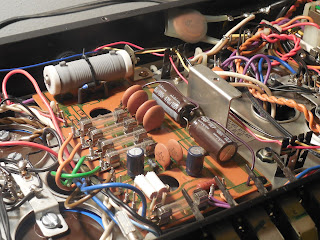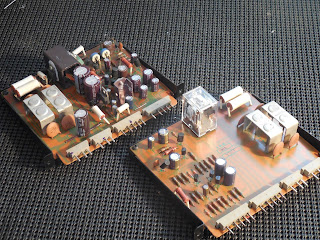Pioneer SX-1250 Receiver
Pioneer SX-1250 Monster Receiver
Here we have the famous Pioneer SX-1250 Receiver. Built from 1977 to 1979, the 1250 is the predecessor of the larger 1980 and version one of the SX-1280. The 1250 is a massive unit, with a 62+Lbs chassis, massive heatsink platforms with dual symmetric driver topographies. Each sectional is provided with 44,000 microfarads of filtering! The 1250 continues to impress, with detailed presentation and an overall well-roundedness, these play well with just about everyone.
Power Supply (PSI) AWR-107 PCB
The power supply for the SX-1250 is feed through separated Pformer primary taps for ideal AC separation, feed into dual rectification for each channel via indecent bridge rectifiers filtering at 44,000 microfarads each. The 1250 has a massive Toroidal Pformer, due to their characteristics of high quality toroidal winding after load in resistance and inductance breakdown is almost negligible , due to this factor a MASSIVE current limiting resistor is used tied to a thermistor device (R1 3.3 Ohm 20W!) due to this the PCB and soldering junctions are severally toasted and need to be addressed, because of the surge suppression circuit a 48Vdc Relay is in line with the inline fusing and secondary rectification to shunt in cause of failure or surge. Another eat caveat of the 1250 PS is the use of rectified DC lamp rails, most 70’s era equipment, even in the top tier still used incandescent AC lamps, DC rails allows for a more stabile illumination and longer bulb life.
All the radial capacitors were replaced with high temp (105C) long life Panasonic FC’ capacitors, as many of you know I hate axial constructed capacitors, the AWR-107 uses two massive 470/100MFD axial capacitors, these were replaced with radial counterparts using low impedance high temp (105C) variant Nichicon PW’s and fixed to the PCB.
New high grade Nippon filter capacitors were replaced, using 22,000 MFD 100V screw terminated type.
Protection AWM-091 (PSIII) PCB & Stabilizer AWR-106 (PSII) PCB’s
The SX-1250 protection circuit employs the use of three activations in 3 stages, DC deviation protection for your speakers, DC overload saturation of the power transistor devices and finally On/Off cycle muting, which is very similar to the soft start integration. A MY-4 DPDT 24Dc relay is coupled with the output stage devices, which was replaced with a low Noise Omron MY4. The overload protection is designed in series of resistors who’s potential dictates the cutoff point, inline with the relay drive circuit and is expelled via a cut off point, as with the excessive current flow turning on the Q1 flowing through D3 which is then shunted via C1 capacitor. All the electrolytics were replaced with either low impedance, high temp variant PWs or Panasonic high temp FC’s, differential pick up transistors on the stabilizer updated right angle potentiometers installed. On the Protection I should note that the 945 class BJT’s tend to fail or become open during loads causing relay malfunctions, a second attempt on this PCB replaced all BJT,s with 1845, 992 low signal devices and 2690 TO-tabbed devices and updated diodes to all 1n4148 type. Due to the large limiter resistors and its location the stabilizer PCB suffers excessive heat issues, all solder junctions must be at minimal reflowed on this PCB.
Power Amplifier AWH-048 PCB
One of the most important stages of the receiver short of the PS in my opinion, so I always takes special care here to optimize what we can. Designed around a classic a/b configuration the x1250 encompasses a 1st order differential pair gain stage tied to a constant current mirror design which mutually phases signal for a more stabile drive via Q3-4 und Q5/6 through a/b biasing resulting in a PP bias scheme. 3rd order drive is comprised of a tiered complimentary darlington arrangement via BJT’s through to outputs. This is a vastly different circuit employees versus the 1280.
The differential pair transistors were updated to matched he KSA992 transistors along with Q11 to low signal KSC1845 transistors, 2nd order were updated to 2690/1220A transistors and 3order drivers to MJE15033/32 50W250V devices with new thermal compound and mica insulators. All electrolytic were updated to low impedance high temp (105C) Nichicon PW and audio grade FG’ Nichicon (.22MFD), new high grade Panasonic ECW polypropylenes (1MFD) and right angle pots. Pin connectors were all reflowed do to the vertical stress of the PCB. TO-3 banks were pulled and re-greased as well.
Audio Notizen
Bias beim punkten #7 und #19 fur 100mV links und recht
Phono/RIAA AWF-021 & Filter Amp AWM-089 PCB’s
The AWF-021 circuit uses a tied emitter differential transistor group for 1st order gain while employing a SEPP )(single ended pp) complimentary circuit for voltage gain drive, high grade polystyrene and precision 1>% resistors results in incredible noise reduction and almost no discernible deviation (>.2dB) All the electrolytic were replaced audio grade Nichicon KA and low impedance Nichicon PW capacitors, differential pair updated and original mylar upgraded to high grade Panasonic ECW polypropylene film capacitors.
The Filter Amp assembly is comprised of a 2 tied capacitor/resistor emitter NFB circuit resulting in apparently sharper filter response. The AWM-089 originally hosted a plethora of tantalum capacitors, tantalum capacitors are considered poor due to their potential microphonic and poor audio characteristics, they also do not uniformly conform and tend to fail rather catastrophically, these were all replaced with low impedance Nichicon PW capacitors. Its important at this stage to pull the remaining switching assemblies so you can properly clean everything.
Flat Amp AWG-042 & Control Amp AWG-041
The pre-amp uses a complimentary set of FET transistors tied to a direct coupled drive stage. Control assembly AWG-041 is a two stage NFB circuit designed to allow low frequency attenuations (ultraslow and to extreme). One nice point on the SX1250 is the use of extra shielding on the tone amp PCB, this is in proximity to the RF stage gang capacitor and with open framed potentiometers is makes a significant difference in noise reduction. All tantalum capacitors on the flat were removed and replaced with low impedance PWs, all others were replaced with low impedance PW and audio grade Nichicon KA capacitors. All 1 MFD films were replaced with high quality Panasonic ECW polypropylene film capacitors.
Control Amp AWG-041
Tuner Assembly AWE-068
The SX-1250 has an incredible FM/AM sectional, with a highly sensitive 5-gang FM tuning capacitor and 3 gang AM, the fm is driven from a dual stage gain circuit while employing an array of MOS/FET and AM IC gain stages (HA1138). Both tuning capacitors were carefully cleaned and treated, all electrlyotics over .1MFD were replaced with high temp (105C) low impedance Nichicon PW type while .1> were replaced with stacked WIMA film capacitors (whites). The nice addition is the shielding used in front end chassis, all RIAA and RF stages have separated shielding.
Audio Notizen
1Khz @ 4.5 Ohm
Links
4.024
13.25 (39.01W
Recht
4.029
13.01 (37.61W
10Khz @ 4.5 Ohm
Links
5.10 (5.78W
26.06 (150W PICTURED & CLOSE UP WAVE
Recht
5.08 (5.73W
25.51 (144W PICTURED & CLOSE UP WAVE



























Noah did a FANTASTIC job on my Pioneer SX-1250, i have been playing it for a month and am impressed daily with its performance. Thanks Again Noah, now for the next one. Rick
ReplyDeleteJust beautiful
ReplyDelete